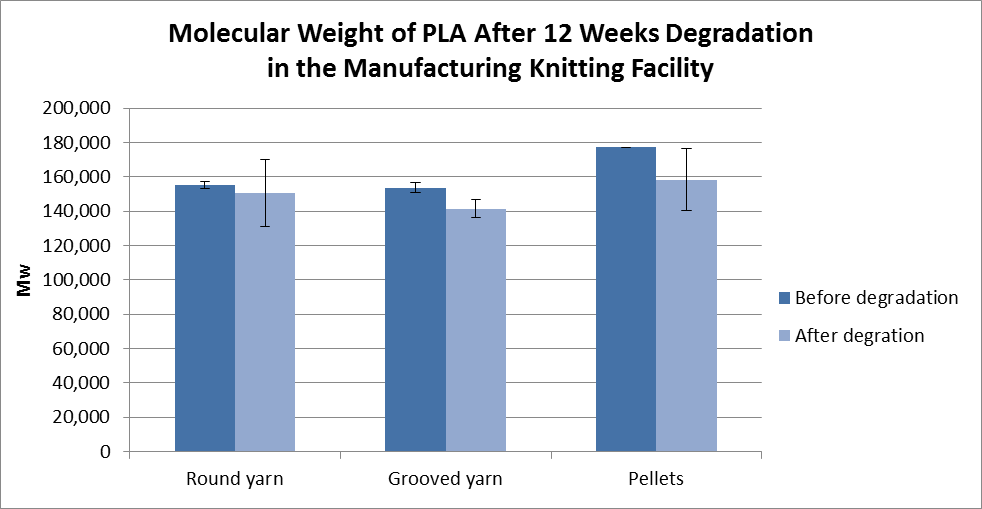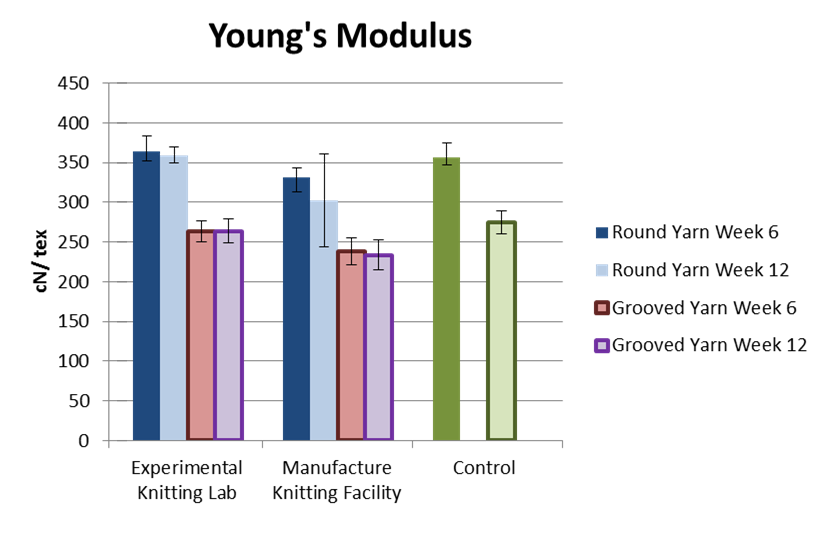Introduction: Polylactic acid (PLA) is one of the commonly used yarn materials in bio-medical textile products[1], such as vascular grafts and hernia meshes[2]. The degradability of PLA structure is critical to its performance after implantation as well as the quality control of the product during manufacture. The rate of degradation of PLA polymer under in vitro conditions has been intensively researched[3]. However, the degradation performance of PLA yarns during processing under industrial textile manufacturing conditions has not been addressed.
Materials and Methods: This research project studied the change of weight, tensile properties and molecular weight of PLA yarns with different fiber morphologies under the influence of moisture, temperature, and exposure time. The PLA pellets were extruded into yarns with round and grooved fiber cross-sections (Figure 1), and then cut into 100 meter lengths. The round and grooved yarns and an equal amount of pellets were exposed to 7 different conditions: four reference conditions that relative humidity (RH) was controlled at 0, 35%, 65%, and 100%; a standard environment of 65% RH and 21oC; an experimental textile knitting lab without moisture or temperature control; a manufacturing facility with limited moisture and temperature control. All the conditions are compared to the frozen-sealed storage condition. The samples were simultaneously exposed to these conditions for up to 21 weeks. Every two weeks, 3 samples of each yarn and pellets were retrieved. The bone dry weight, tensile strength, tensile strain, Young’s modulus and molecular weight of the PLA yarns are measured before and after the exposure.

Figure 1: the tropology information of PLA yarns.
The results indicated that, the rate of molecular weight loss of the PLA yarns and pellets accelerated over time, with less than 10% in the first 12 weeks, but more than 10% in the following 9 weeks. The grooved fibers with a larger surface area were more sensitive to the moisture (Figure 2). And the pellets showed more weight loss than the fully drawn yarns (Figure 2).

Figure 2: the molecular weight of PLA after 12 weeks degradation in manufacturing knitting facilities.
Both the round and grooved yarns experience tensile strength loss after 12 weeks, and the average decrease of tensile strength was lower than 5%. The round yarns showed more loss of Young’s Modulus than the grooved yarns (Figure 3).

Figure 3: the change of Young’s Modulus of round and grooved yarns after 6 and 12 weeks exposure in the experimental knitting lab and manufacture knitting facility, in comparison with the yarn sample stored in a frozen and sealed condition (control).
The outcomes of this research illustrate that industry should lower the relative humidity to maintain the necessary properties. In order to minimize the degradation during the manufacturing, the whole process after yarn extrusion till the end of fabrication should be managed within 12 weeks under optimal moisture conditions. Further study is required to identify the rate and extent of degradation associated with the cleaning and sterilization procedures following fabrication.
Brian Davis, Knitting Lab Manager, North Carolina State University; Birgit Andersen, TECS Lab Manager, North Carolina State University
References:
[1] R. S. Blackburn and E. Textile Institute (Manchester. Biodegradable and Sustainable Fibres 2005.
[2] M. K. Mitchell and D. E. Hirt. Degradation of PLA fibers at elevated temperature and humidity. Polymer Engineering & Science 55(7), pp. 1652-1660. 2015.
[3] S. Wu, P. Zhang and Z. Guo. The properties of braided yarns with different PGA/PLA proportions in vitro degradation. Donghua Daxue Xuebao (Ziran Ban)/ Journal of Donghua Univeristy 35(3), pp. 274-278-303. 2009.